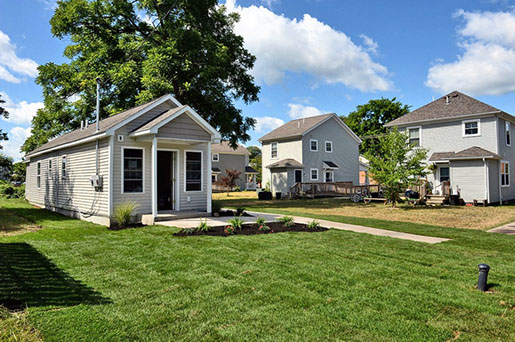
Tiny homes sprout in Syracuse, shelter for homeless vets
By Tim Knauss | tknauss@syracuse.com
SYRACUSE, N.Y. – In color and finish, the two recently completed townhouses on Rose Avenue blend in with other new homes in the neighborhood. But in size, or lack thereof, they stand out.
Each of the new townhouses contains just 240 square feet of living space, one-fifth as much as the nearby single-family colonials.
Syracuse's first two tiny homes – or at least the first of recent times – are nearly ready for occupancy. They will provide permanent shelter for two military veterans who have been homeless.
The completion of the tiny homes is a big milestone for the small nonprofit group that built them, A Tiny Home for Good Inc.
Founded and directed by 26-year-old Le Moyne College alumnus Andrew Lunetta, the group spent two years in an often frustrating quest to find the right location to build. Two previous sites were abandoned after neighbors objected. Another building lot was obtained only after long delays.
But now A Tiny Home has hit its stride.
As the group puts finishing touches on homes at 112 Rose Ave., on the city's South Side, volunteers are preparing to start work at a second site. Three tiny homes will be built at the corner of South Salina Street and East Glen Avenue. Those homes are expected to be ready for occupancy in September, Lunetta said.
The Tiny Home group got a big boost when it joined forces last year with another Syracuse-area nonprofit, Operation Northern Comfort, which raised money to buy materials and provided experienced volunteers to help guide the construction of the Rose Avenue homes, Lunetta said.
Tiny homes provide an alternative to the often high cost of developing low-income housing, advocates say.
Built with volunteer labor from roughly 50 volunteers, the two homes on Rose Avenue cost just under $25,000 each, Lunetta said.
Compare that to the cost of VanKeuren Square, a state-of-the-art East Side housing complex for homeless vets that cost $11.4 million for 50 units, or $228,000 per apartment.
The tiny homes are modest. Each measures 12 feet by 20, about the size of a master bedroom in the average new American home.
Each unit has a single room that includes living area, bed and kitchen. There's a separate bathroom, and . . . well, not much more. There's a small shed out back to hold bikes and stuff.
A Tiny Home for Good has attracted help from a wide range of volunteers, Lunetta said. Hadley's LLC, of Jamesville provided free landscaping for the Rose Avenue homes. Hayner Hoyt Construction Co. will help erect the houses at East Glen Avenue, on a lot donated by Lamar Advertising, the billboard company.
Lunetta said it's possible that in the future A Tiny Home for Good will also build market-rate tiny homes to generate funding to continue its work for the homeless.
Other efforts to build tiny homes are slowly taking shape in Syracuse.
Serenity Women's Center, a nonprofit group started by Syracuse restaurateurs Cindy Seymour and Laura Serway, plans to build three tiny homes for female vets near the Rescue Mission. Details of that project are still being worked out, Seymour said.
A Tiny Home for Good will hold a ribbon cutting for the Rose Avenue homes at 10 a.m. Friday. Syracuse Mayor Stephanie Miner and other officials are scheduled to attend.